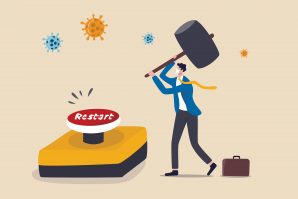Video meetings. Laptops on the sofa. Awkward, stale jokes about “working in my pajamas.” Many of us have been there for some time, and some of us will stay there — working from home, pajamas and all — for months or even years.
A study from Global Workplace Analytics estimates companies will save, on average, $11,000 per year for every employee who shifts to part-time telecommuting. The report says the primary savings come from increased productivity, lower real estate costs, reduced absenteeism and turnover, and better disaster preparedness.
This coronavirus pandemic could mark the biggest shift to the workplace since the adoption of computers, ushering in changes that could ripple across the physical design of offices, employee productivity and organizational effectiveness.
Are we more productive when working from home because we ditch our commutes and spend less time in meetings? Or do we get less done, because it’s easier to loaf? “It depends,” says Lisa Montanaro, a Sacramento productivity consultant. Some of her clients say they’re more productive from home, others say the opposite. “It so depends on the person,” agrees Cami McLaren, a performance coach in Sacramento who works with attorneys and other professionals. “Some people are much more disciplined than others, and working from home is not going to work for a lot of people.”
If one of the factors of remote working success is self-discipline, another is the employee’s social inclinations. “If they’re introverted, they could be doing really well at home, as they’re not forced to be in big group meetings,” says Montanaro. “And maybe the extrovert is missing the social activity of being around people.” (Perhaps the biggest factor of remote-work productivity is out of many employees’ hands: child care duties, which are most often borne by women. But to explore a post- pandemic workplace, we’ll assume this issue is off the table, and all employees are free from the extra parenting of the COVID-19 era.)
A more subtle factor is what Montanaro calls the “life-work integration model.” When we work from home, our schedules tend to be more fluid, which some people love and others loathe. One of Montanaro’s clients, for example, used to work in the office from around 8 a.m. to 6 p.m. Now he works at home from 8 a.m. to 10 p.m., but he takes a three-hour break and eats lunch with his kids. He loves it — usually. “And I have other clients where, if they’re working at 10 p.m., no matter how many breaks they have, they’ll resent it,” Montanaro says.
When sheltering in place began, McLaren quickly put together a webinar about how to effectively work from home. Key concept: The importance of creating anchors. “An anchor is a physical thing that reminds you of something and makes your brain do a certain thing,” says McLaren. If you go into the office every day, those pale blue and gray cubicles are anchors that tell your body you’re here to work. “If you try to work from home, there’s no real anchor,” says McLaren. “That’s an anchor for relaxation and playing around.”
She recommends we create anchors by always working in a certain part of the home (such as sitting upright at the kitchen table, as opposed to slumped on the sofa), or only during certain hours (like starting at 8 a.m. sharp, and closing down at 5 p.m.). So if the world pivots to working at home long-term, it will be important to create and honor anchors.
Effect on the Organization
It’s one thing for organizations to go virtual for a month or two during the crucible of a pandemic. That’s a stopgap. But what if it becomes the new normal? How would that affect the bonds and cohesion of the organization? “I think we’re going to see a huge shift,” says Sargam Garg, a business professor at Sacramento State who studies organizational behavior. She expects a shift in an organizational framework known as the psychological contract, developed by Denise M. Rousseau of Carnegie Mellon University. According to the psychological contract, thanks to the principle of reciprocity, we give an organization what we feel we are owed.
“But with virtual contexts, everything will change,” explains Garg. “How do I perceive what the employer owes me? What are my obligations?” Physical contexts matter. Symbols matter. When you go into an office building every day, you’re subconsciously reminded of the company logo, the company’s values and the sense that you’re all on the same team. When we’re all in our own homes, we lose that sense of shared identity, so we’re less certain of our place and value. “With the virtual context, organizations will be strained to think about a sense of belonging,” says Garg. She says one simple thing organizations can do to reinforce that shared identity is to use the same backgrounds during videoconferencing. This provides a visual cue of solidarity, just as the Sacramento Kings’ uniforms provide a visual reminder that they are all on the same team.
The longer we work from home, the more our connections with coworkers will be tested and frayed. Garg cites the theory of high-quality connections from University of Michigan professor Jane Dutton, where you sponge energy from your friends and peers. A high-quality connection, explains Garg, “doesn’t have to be a long-term relationship. It can be a short-term encounter. You feel energized by somebody, you feel that you’ve connected.” You get a quick jolt from hallway small talk or elevator ride or from swapping gossip on the way to the parking lot. These high-quality connections help keep employees motivated and engaged. “Frankly, half the fun of going to work is the people I work with,” says Dan Corfee, who manages the Sacramento office portfolio of real-estate company Buzz Oates. “I really miss them.”
In the expanded world of remote work, the onus is on managers to find creative ways to preserve employee engagement. Sharyn Gardner, a management professor at Sacramento State, suggests managers hold “office hours” — a standing time when the boss is available for virtual pop ins — maybe every day when eating lunch at noon, allowing for informal chats. Gardner also stresses the importance of continuity (from the pre-COVID world) and routines. “Don’t lose your routines,” advises Gardner. “Keep those weekly meetings.”
Check-ins have become more important. “You have to be intentional about it,” says Michelle Payne, another Sacramento leadership coach. She instructs her clients to set up frequent one-on-one check-ins, where they can get a bit more personal and ask, “No, how are you really doing?” Payne says her clients struggling the most are the ones who aren’t doing one-on-ones, because they’re “losing track of what’s going on with their people.” And fun is still encouraged. McLaren suggests a weekly happy hour, where perhaps Friday’s last meeting ends at 4 p.m., and then everyone is welcome to break out a cold one.
When organizations go remote, they risk losing that hard-to-quantify “institutional knowledge” that tends to float through the office hallways. Gardner calls this “tacit knowledge,” such as the location of that one weird file that everyone forgets. Tacit knowledge is often held by, as Gardner puts it, “that one person who has worked here for forever, and you just say, ‘Go ask Bob!’ He knows the information that’s not codified.”
Clear, crisp communication becomes vital in a virtual workplace. “When we were all working together having hallway conversations, we didn’t have to be as clear,” says Payne. If you were fuzzy on the details, it was easy to swing by the next cubicle for clarification. Hallway chitchat had merit. “Now it has to be very clear,” says Payne. The silver lining? McLaren says that when companies are forced to communicate more explicitly, it can lead to new efficiencies. Her lawyer clients told her that in the beginning of the pandemic, firms told them to turn in their timesheet every week — which was not always the case pre-COVID. “The lawyers were really happy about that,” says McLaren. “They were being told what the expectation was and when to turn it in, and it gave them some accountability.”
No matter how the pandemic shakes out, and no matter how many companies pivot to long-term remote work, McLaren provides a nice dollop of perspective: In some sense, where you work is not, ultimately, what determines your effectiveness. Go-getters will hustle whether in a cubicle or at their kitchen table. Slackers will find ways to do less with more, no matter the context. “Honestly, if you’re not motivated to do your work, that’s going to be a problem no matter where you are,” says McLaren. “This idea that you should have the people in the office is kind of authoritarian. If you brought somebody into your building and they don’t want to do work for you, how much more productive are they?” She pauses. “You can just watch them better.”
Offices: Smaller or Bigger
As companies and employees adjust to telecommuting, there’s been a lot of chatter about a glut of office space, putting downward pressure on lease prices, but many experts disagree.
“The reality is, I don’t think any of us know for sure how it’s going to shake out,” says Corfee. Although, if Corfee had to guess, he’s not anticipating a future surplus of space. “There’s no supply in Sacramento for a big user,” says Corfee, referring to the office needs of large companies. “There isn’t any space. Nobody’s built space here (in the downtown market) in 10 years.”
Local executives at CBRE, the real estate and investment firm, agree. Sacramento is filled with “recession-resilient industries,” such as government and health care, says David Brennan, senior managing director of CBRE’s Sacramento region, that will have a strong demand for offices even after the pandemic. And even if some Sacramento companies (or government offices) decide to downsize, he expects inventory to quickly get snapped up. “If some office space does open up in light of the pandemic,” says Brennan, “that space will be very attractive to Bay Area companies looking to relocate or expand their operations in a cost- competitive market.”
Corfee and Brennan say very few of their clients are looking to break their lease or allow it to lapse. Some Buzz Oates clients are looking to downsize, but Corfee says that’s offset by companies seeking more space to allow for roomier social distancing. Corfee says in recent years, “in the office sectors of the urban cores especially, (companies) spent a lot of money cramming people together.” He expects many firms to want twice the square footage per employee and will switch to floor plans with more private offices and less common space. “Companies spent 10 years figuring how to cram 20 pounds of employees in a 10 pound bag,” says Corfee, “and now they’re going to spend 10 years putting 10 pounds of employees in a 20 pound bag.”
–
Stay up to date on the effects of the coronavirus on people and business in the Capital Region: Subscribe to the Comstock’s newsletter today.
Recommended For You

Dilemma of the Month: How You Can Help Your Workers Return
How can employers respond to employees’ concerns as they return
to the office or opt not to do so?

Dilemma of the Month: How Working Remotely Can Be Effective for Your Company
Employers are considering making the temporary measures for
people to work from home caused by the coronavirus lockdown more
formal. What are their obligations to their employees?

What Will Telecommuting Look Like After COVID-19?
As a result of the coronavirus stay-at-home orders across most states, workers have been switched to telecommuting at rates that were unthinkable even a few months ago. The question is: Where do we go from here?

Back to Business — Not as Usual
Four strategies to help employers avoid litigation as California reopens
Companies can expect to see COVID-19-related employment lawsuits from nearly any corner. These strategies can help mitigate risk.





